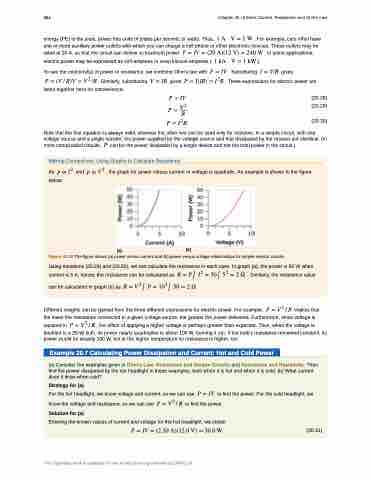Page 906 - College Physics For AP Courses
P. 906
894 Chapter 20 | Electric Current, Resistance, and Ohm's Law
energy (PE) is the joule, power has units of joules per second, or watts. Thus, � � � � � � � . For example, cars often have one or more auxiliary power outlets with which you can charge a cell phone or other electronic devices. These outlets may be rated at 20 A, so that the circuit can deliver a maximum power � � �� � ��� ����� �� � ��� � . In some applications,
electric power may be expressed as volt-amperes or even kilovolt-amperes ( � �� � � � � �� ).
To see the relationship of power to resistance, we combine Ohm's law with � � �� . Substituting � � ��� gives
� � �� � ��� � � � �� . Similarly, substituting � � �� gives � � ����� � � �� . Three expressions for electric power are listed together here for convenience:
� � �� (20.28) ���� (20.29)
�
� � ���� (20.30)
Note that the first equation is always valid, whereas the other two can be used only for resistors. In a simple circuit, with one voltage source and a single resistor, the power supplied by the voltage source and that dissipated by the resistor are identical. (In more complicated circuits, � can be the power dissipated by a single device and not the total power in the circuit.)
Different insights can be gained from the three different expressions for electric power. For example, � � � � � � implies that
the lower the resistance connected to a given voltage source, the greater the power delivered. Furthermore, since voltage is
squared in � � � � � � , the effect of applying a higher voltage is perhaps greater than expected. Thus, when the voltage is
doubled to a 25-W bulb, its power nearly quadruples to about 100 W, burning it out. If the bulb's resistance remained constant, its power would be exactly 100 W, but at the higher temperature its resistance is higher, too.
Making Connections: Using Graphs to Calculate Resistance
As � � � � and � � � � , the graph for power versus current or voltage is quadratic. An example is shown in the figure below.
(a) (b)
Figure 20.18 The figure shows (a) power versus current and (b) power versus voltage relationships for simple resistor circuits.
Using equations (20.29) and (20.30), we can calculate the resistance in each case. In graph (a), the power is 50 W when
current is 5 A; hence, the resistance can be calculated as � � �� �� � ��� �� � � � . Similarly, the resistance value can be calculated in graph (b) as � � � � � � � ��� � �� � � �
Example 20.7 Calculating Power Dissipation and Current: Hot and Cold Power
(a) Consider the examples given in Ohm's Law: Resistance and Simple Circuits and Resistance and Resistivity. Then find the power dissipated by the car headlight in these examples, both when it is hot and when it is cold. (b) What current does it draw when cold?
Strategy for (a)
For the hot headlight, we know voltage and current, so we can use � � �� to find the power. For the cold headlight, we know the voltage and resistance, so we can use � � � � � � to find the power.
Solution for (a)
Entering the known values of current and voltage for the hot headlight, we obtain
� � �� � ����� ������� �� � ���� �� (20.31)
This OpenStax book is available for free at http://cnx.org/content/col11844/1.14


